The Elijah Paintings
Introduction to the Elijah Paintings
The story, found in the book of Kings, took place in the 8th century BC sixty-five years after the death of King Solomon and the civil war that split Israel into the northern kingdom called Israel and the southern kingdom called Judah. Successive kings, three in the south and seven in the north, had led a people rescued from Egyptian slavery and schooled in the desert by Moses away from their true calling and identity. Others gods with their magical and demeaning practices of cult prostitution and human child sacrifice had been welcomed into a smorgasbord of religious activity. And the prophets of the one and true God, Yahweh, had been killed or banished to hide in caves.
Into this scene stepped a prophet, Elijah, whose name means El is Yah or God is Yahweh. His job was to confront false religion, clear out the pantheon, and called a recalcitrant people back to their roots. He performed his dangerous task with authority, humility, and humor.
The Elijah paintings are my attempt to engage the text artistically. The mental process of trying to produce a painting helped the story come alive for me. These paintings are more symbolic and less representational.. I have adopted a modern art style developed by such artists as Henri Matisse and Pablo Picasso. Picasso was intrigued by traditional African Masks. As an art form, they created a bridge between the visible world and the world of the spirits. Bridge building is my intention too—between the Scriptures and present life. Each painting is a watercolor collage on 140 pound cold press watercolor paper. They are matted to fit in a 16×20 frame.
The Widow at Zarephath
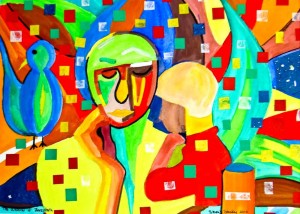 She was a minor character in a great drama. We don’t even know her name. She was a person who suffered at the margins of society. Without husband or the help of extended family, she did what she could to scrape by. When she met Elijah she was at the end of her rope, without food or hope for herself and her young son. She was from the same gentile country as Queen Jezebel. Her people were seaman. Might her husband have been a sailor lost at sea? Might she have been a foreign born immigrant or refugee alone in a strange country? Was her son an anchor child? She seemed to me to be a good woman. She was hospitable to Elijah even in her poverty.
She was a minor character in a great drama. We don’t even know her name. She was a person who suffered at the margins of society. Without husband or the help of extended family, she did what she could to scrape by. When she met Elijah she was at the end of her rope, without food or hope for herself and her young son. She was from the same gentile country as Queen Jezebel. Her people were seaman. Might her husband have been a sailor lost at sea? Might she have been a foreign born immigrant or refugee alone in a strange country? Was her son an anchor child? She seemed to me to be a good woman. She was hospitable to Elijah even in her poverty.
The Yahweh said to Elijah, “I have commanded the ravens to provide bread and meat for you by the brook.” When the brook later dried up, He said, “I have commanded a widow at Zarephath to provide you with food.” Raven and widow—both unwitting instruments of the Lord working in the food service industry and contributing to God’s transformation of society. Yet both considered unclean by the dominant Jewish culture. Jesus mentioned this woman in a favorable light 800 years later and almost got killed on the spot as a result..
Dorothea Lang photographed a nameless dust bowl migrant mother and her children in a field outside of Nipomo in 1936. I used that image for this painting.
Obadiah
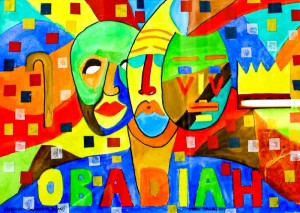 His name means servant of Yahweh. He was in charge of King Ahab’s palace and livestock. Like Joseph, Nehemiah, and Daniel he was called to serve a faithless king. He managed people and things. I imagined him to be hardworking, responsible, loyal, and attentive to details. Day by day he quietly did his job. He may have been so good at what he did that over time he became invisible. That allowed him to work in a clandestine way when Jezebel ordered the killing of the prophets.
His name means servant of Yahweh. He was in charge of King Ahab’s palace and livestock. Like Joseph, Nehemiah, and Daniel he was called to serve a faithless king. He managed people and things. I imagined him to be hardworking, responsible, loyal, and attentive to details. Day by day he quietly did his job. He may have been so good at what he did that over time he became invisible. That allowed him to work in a clandestine way when Jezebel ordered the killing of the prophets.
Elijah confronted apostasy by standing outside or above the social/ political system. Obadiah sought to reform the system and mitigate its evil influences from the inside. Both men experienced the power of God as they carried out their mission. Elijah could be as unpredictable as the wind of the Spirit whereas, predictability and steadfastness where the chief traits that kept Obadiah alive. Both men faced danger and had to hide in order to survive. Obadiah’s hiding was much trickier because it was in plain sight. To be God’s person, I imagined that Obadiah had to create a variety of personas that he would wear depending upon the situation. Reformers working in modern secular institutions must often do the same today.
Elijah at Mt. Carmel
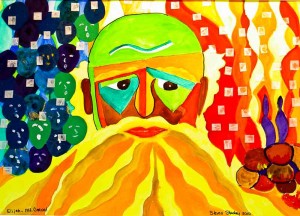 This scene is the dramatic highpoint in the life of Elijah. Belief in the Canaanite storm god, Baal, was put to the test during the three year draught that Elijah ordered. The contest on Mt. Carmel was the climatic final round. Four hundred and fifty prophets of Baal squared off against Elijah, prophet of Yahweh.
This scene is the dramatic highpoint in the life of Elijah. Belief in the Canaanite storm god, Baal, was put to the test during the three year draught that Elijah ordered. The contest on Mt. Carmel was the climatic final round. Four hundred and fifty prophets of Baal squared off against Elijah, prophet of Yahweh.
Elijah was masterful. He laid out the grounds rules. The god who answered by fire was the true God . The Baal prophets went first. Elijah egged them on with ridicule and humor that came straight out of their religious texts. No response from the heavens. Then Elijah repaired the Lord’s altar, laid out the sacrifice, drenched it in water for good measure, and called upon Yahweh. The fire of judgment fell.
Two things caught my attention. First , the fire of judgment that could have rightly fallen on the people and the king, fell on the sacrifice. This was an act of power but more importantly mercy. Rightly understood, it was a reenactment of the covenant superintended by Moses on Mt Horeb. Israel was given another chance. Secondly, the people screamed Yahweh-he is God. That was the meaning of Elijah’s name—El is Yah or God is Yahweh.
Race to Jezreel
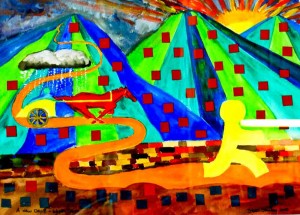 The false prophets were killed, the covenant meal was eaten, and the king seemed to submit to every request made by Elijah. The sun was beginning to set marking a new day for the nation of Israel. Elijah prayed for rain and then ordered Ahab to race back to Jezreel before he got stuck in the mud. Then a strange thing happened. Elijah, in the power of the lord ran back to Jezreel ahead of the King. Why?
The false prophets were killed, the covenant meal was eaten, and the king seemed to submit to every request made by Elijah. The sun was beginning to set marking a new day for the nation of Israel. Elijah prayed for rain and then ordered Ahab to race back to Jezreel before he got stuck in the mud. Then a strange thing happened. Elijah, in the power of the lord ran back to Jezreel ahead of the King. Why?
Who runs ahead of a King? The forerunner announcing the coming of the Lord and His blessing., that’s who. Order was being reestablished—God, prophet, king, and obedient people. Everything was looking up. But was it?
To suggest that the victory on Mt Carmel might be stillborn, I included two modern symbols. I used the AOL instant messenger for Elijah to indicate that his message on the mountain might not be as permanent as it first appeared. Secondly I used the Ford Mustang logo for the horse pulling Ahab’s chariot. This was to suggest that a wild untamable woman with blood on her hands may be running the country, not milk-toast Ahab.
Jezebel
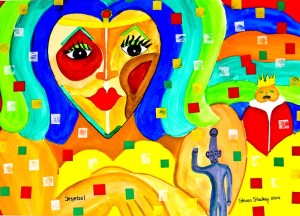 Her father was Etybaal, King of Sidon and a priest of Baal the local storm God. Her marriage to King Ahab of Israel helped strengthen Ahab’s hand against his enemies to the north. He probably got more than he bargained for. Jezebel brought along 450 prophets of Baal and 400 prophets of the goddess Asherah. Then she proceeded to eliminate the worship of Yahweh by killing his prophets.
Her father was Etybaal, King of Sidon and a priest of Baal the local storm God. Her marriage to King Ahab of Israel helped strengthen Ahab’s hand against his enemies to the north. He probably got more than he bargained for. Jezebel brought along 450 prophets of Baal and 400 prophets of the goddess Asherah. Then she proceeded to eliminate the worship of Yahweh by killing his prophets.
The concept of big and small interested me. Yahweh is portrayed in scripture as big, grand and spacious. His power is limitless, His love and mercy boundless, His holiness is pure. Man, on the other hand is pictured as much loved but dependant, transient, and corrupt. False religion reverses that order. Man is made big and the gods are small, petty, and undependable.
Jezebel fills the frame while Baal and Ahab play minor roles in her drama. I imagined her as an overexposed Hollywood starlit whose days are numbered. In our culture she might be more pathetic were her type not so popular. We tend to idolize her kind instead of the other woman from Sidon, the widow of Zarephath.
Valley of the Shadow
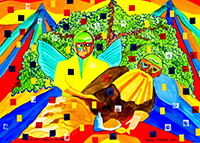 The victory at Mt Carmel was short lived. Jezebel put out a contract on Elijah’s life and he fled south He may have been emotionally exhausted, angry, despondent over the prospects for Israel, in grief, or without hope. Today we might call it post traumatic stress. Whatever, he was ready to give up and die and in fact something in Elijah did die that day.
The victory at Mt Carmel was short lived. Jezebel put out a contract on Elijah’s life and he fled south He may have been emotionally exhausted, angry, despondent over the prospects for Israel, in grief, or without hope. Today we might call it post traumatic stress. Whatever, he was ready to give up and die and in fact something in Elijah did die that day.
I was struck with the tenderness of the scene. It takes place between two mountains, Mt Carmel and Mt. Horeb, the mountain of God visited by Moses. An angel bakes bread over hot coals, wakes and feeds him twice before he is sent on his way to confer with the Yahweh over the fate of Israel. I noted that the ravens and the widow provided him with bread and drink in the previous chapters so I painted the angel using the image of the widow and gave her raven wings. I was reminded of Jesus feeding bread and fish to the discouraged disciples by the Sea of Galilee in John 21 so I added a fish to the menu options.
The Still Small Voice
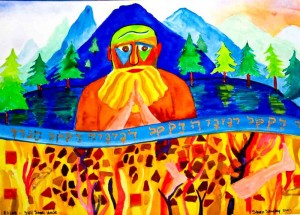 Elijah was summoned to meet Yahweh on Mt. Horeb. He spent the night in a cave. The next morning he was greeted by a spectacular display of earth, wind, and fire. Those phenomenon were the royal cavalry that proceeded a great king who followed behind. But to Elijah’s surprise the king appeared in a still small voice or a gentle whisper.
Elijah was summoned to meet Yahweh on Mt. Horeb. He spent the night in a cave. The next morning he was greeted by a spectacular display of earth, wind, and fire. Those phenomenon were the royal cavalry that proceeded a great king who followed behind. But to Elijah’s surprise the king appeared in a still small voice or a gentle whisper.
As I imagined the scene, I focused on Elijah’s internal state. He struggled with a whirlwind of emotions (fear, anger, grief, frustration, sadness, and isolation) that shook his foundations. His soul was seared by fireballs of hatred hurled by Jezebel. But when he heard the still small voice, it calmed him. The Good Shepherd of Psalm 23 had led his servant to green pastures, still waters, and restored his soul. In the same way that Moses glowed when in the gracious presence of Yahweh, Elijah grew calm and peaceful. In the end he was ready to receive a new commission and return to duty.
The painting reflects Elijah’s disintegration and restoration. The letters on the blue band are Hebrew and say “still small voice” three times and include the word gracious.
Chariots of Fire
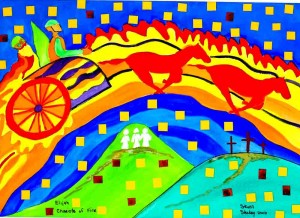 Elijah departs this world in a blaze of glory. Fire, pure energy, is an image of God in the Scriptures. It features prominently in the life of Elijah as it did in the life of Moses. For Christians both men are forever linked to each other as they are to Jesus in the New Testament. Moses and Elijah, the Law and the Prophets, find their completion in the life of Jesus. Both depart earth in an unusual way. Both reappear with Jesus on the mount of transfiguration to discuss his own departure from earth. For my Jewish friends, Elijah is the honored guest at each Passover.
Elijah departs this world in a blaze of glory. Fire, pure energy, is an image of God in the Scriptures. It features prominently in the life of Elijah as it did in the life of Moses. For Christians both men are forever linked to each other as they are to Jesus in the New Testament. Moses and Elijah, the Law and the Prophets, find their completion in the life of Jesus. Both depart earth in an unusual way. Both reappear with Jesus on the mount of transfiguration to discuss his own departure from earth. For my Jewish friends, Elijah is the honored guest at each Passover.
In this painting I imagined Elijah roaring out of the Old Testament into the futue. He is an example of one who with God’s help was faithful to the end. Even though his life work remained an unfinished symphony . But in truth he has no end. His story and his example live on in scripture, in art, and in the imagination. Amen
